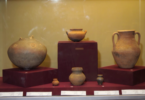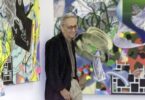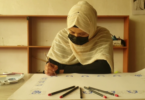Shaikh Ayaz
Sayed Haider Raza was a modernist giant whose signature Bindu — mainly acrylic-based paintings of large black circles or dots, accompanied by geometric grids that riff on ancient Hindu concepts of spirituality — are some of the most sought-after and expensive pieces of art in the Indian pantheon. But how did the artist, often referred to as SH Raza, arrive at this stylistic breakthrough that changed Indian modern art forever?
Having opted for a more encyclopaedic approach to his life and times, Centre Pompidou’s major new retrospective on Raza provides some useful clues. Simply titled Sayed Haider Raza, the Paris show presents a sprawling collection of more than 90 paintings and around 80 letters and documents including zealously-preserved notebooks.
:quality(70)/cloudfront-eu-central-1.images.arcpublishing.com/thenational/7UQN4OMN3VA25FKE4DS4CNZUAI.TIF)
It’s a good opportunity to see some of his best-known works from an extraordinary career spanning nearly 70 years, such as Aarambh, Maa, Nagas, Zamin, Surya Namaskar, Haut de Cagnes, Bindu, La Terre and Saurashtra, which was auctioned for $3.5 million in 2010, setting a record for a modern Indian work according to Christie’s.
Even though Raza spent more than six decades living in France, it’s the first time that Paris is hosting such a prodigious survey of his career. “It is perhaps one of the largest and most ambitious shows of any modern Indian artist in Europe,” says Ashok Vajpeyi, managing trustee of the New Delhi arts non-profit organisation, The Raza Foundation.
Held in collaboration with Centre Pompidou and the foundation, the exhibition tries to tap into the artist’s role as a bridge-builder between South Asian and European cultures. In the making for some years, the show is an effort to project Raza onto the global stage and indeed, it comes at a particularly momentous time for his legacy. Last year, many galleries and institutions throughout India hosted exhibitions in honour of his birth centenary. “In a way, the celebrations have now shifted from India to Paris,” says Vajpeyi.
:quality(70)/cloudfront-eu-central-1.images.arcpublishing.com/thenational/MZ47G7QKKFH2LI7TCAYXOERQJ4.jpg)
To understand Raza it’s helpful to start at the beginning. Born in 1922 in a small village of Mandla in central India, where his father worked as a forest officer, Raza’s upbringing was humble but full of lush visual and natural beauty — a vivid memory that guided him spiritually and creatively almost throughout his life.
After his parents’ death, most of his family migrated to Pakistan, but Raza remained in India. He went on to study at the prestigious Sir JJ School of Art in Mumbai, where he befriended FN Souza and MF Husain and became the founding member of the Bombay Progressive Artists’ Group, a pioneering post-independence Indian collective that sought to introduce modernism in Indian art. His early phase was marked by vibrant landscapes, predominantly painted in a German expressionist style.
Raza scholars often cite his Kashmir trip in 1948 as a turning point. It was there that he met French photographer Henri Cartier-Bresson, who looked at his work and observed: “Your paintings lack construction. Study Paul Cezanne.”
Two years later, Raza sailed for Paris in 1950 on a French government scholarship. When he landed in Paris he was elated to discover that the French capital was every bit the hive of art that he had imagined it to be. Even though Cezanne and the post-Impressionists were long gone, mid-20th-century Paris was still a heady mix of cafe intellectualism and art-filled salons.
:quality(70)/cloudfront-eu-central-1.images.arcpublishing.com/thenational/NZJH7S7V4BGYPIA4G2SMF3YEYM.JPG)
While Raza started out as a watercolour and gouache specialist in Mumbai of the 1940s, then known as Bombay, his output from his Paris years was largely dominated by Cubist-influenced churches and French villages. Centre Pompidou has displayed a seminal body of his work from this crucial period to give visitors a glimpse into his French influences.
Paintings rendered in thickly impasto technique, such as Untitled (Church in Landscape), Church at Meulan, Eglise et Calvaire Breton and Village, reveal an influence of Ecole de Paris. By the 1970s, his imagery had become progressively abstract, but it was a decade later that the celebrated Bindu series was born.
For better or worse, it is impossible to discuss Raza without the bindu. This series conveys an experience of mystery and eloquent silence, something at once timeless and universal.Raza himself often described the black dot or circle as a “seed of all energy”. Some critics have interpreted it as shunya, or the great void, but Raza was inspired by ancient Sanskrit texts such as the Upanishads, which mention philosophical ideas of bindu and naad in the context of meditation.
For Raza, these energy fields and simplified geometric forms symbolised a point in his life where he realised art’s purpose is to evoke something more than a mere image. Like Mark Rothko, who wanted to move his viewers to tears with basic emotions through nothing but planes of colours, Raza’s idea was to express a sentiment that was beyond human comprehension.
Unlike some of his peers, Raza has always eschewed the notions of history and politics, instead preferring to chase his “intuitions”. In his book about the artist, Sayed Haider Raza, Vajpeyi quotes Raza as saying: “Only a part of the creative process is known to me. So much more is unknown.”
Vajpeyi argues that the highly meditative Bindu series evolved from a case of identity crisis. “Around 1978 or 1979, he started feeling that he had become a painter of the Parisian School,” he says.
“Where was India in his work and where was Raza in it? He then recollected a Proustian memory of his teacher in primary school making a circle and telling this child with a constantly wavering mind to concentrate. This was, according to him, the backstory of the famous Bindu.
“It was important to him because it gave him the idea that what was illogical in life somehow becomes compatible in art.”
:quality(70)/cloudfront-eu-central-1.images.arcpublishing.com/thenational/7WEDRQGGL5EIDB6RSKAAMVGMPQ.jpg)
Susan S Bean, a senior curator of South Asian art who has previously worked with the Peabody Essex Museum in Massachusetts, says that Raza was more interested in “the challenges of visualising India’s cosmologies and creating abstract cosmos-scapes”, which is best exemplified by Udho, Heart is not Ten or Twenty that has been loaned by the museum and is serving as the exhibition’s emblem. Udho, Heart is not Ten or Twenty (1964) is a canvas that combines Raza’s passion for poetry, the format of Rajasthani miniature and an outburst of colour with earthy reds giving off a sublime effect.
Raza had a profound appreciation for Indian colours. “Colour is the essence of my work,” Vajpeyi quotes him as once declaring. From the 1980s onwards, as he became more and more preoccupied with the symbolism of the bindu, he also started exploring the formal qualities of pigments with unusual results.
Even though the bindu gave him fame and success there were also accusations that he was getting repetitive, which he defended unapologetically by comparing his devotion to japmala (chanting) or rosary prayer, where the idea of repetition helps the devotee achieve a state of elevated consciousness.
What one cannot doubt, however, is Raza’s deep bond with his Indian roots. Despite making France his home, he divided his time between Paris and the small Gallic hamlet of Gorbio, and having married French artist Janine Mongillat, he continued to maintain close ties with India.
In fact, his friends recall that his studios in Paris and Gorbio were a shrine to India where he surrounded himself with artefacts, sculptures and miniature paintings that he had collected over the decades on his countless travels to his home country.
“He remained an Indian at heart and proud to be one,” says gallerist Reena Lath, who acted as an advisor on this show. Vajpeyi adds, “He liked to say, ‘I learnt how to paint from France but what to paint from India.”
In the final decade of his life, Raza finally decided to return to India. He died there in 2016 at the age of 94 and was buried next to his father in his ancestral village of Mandla, per his wishes — in the end, becoming one with the soil, landscape and culture that had followed him throughout his life.
Courtesy: thenationalnews







